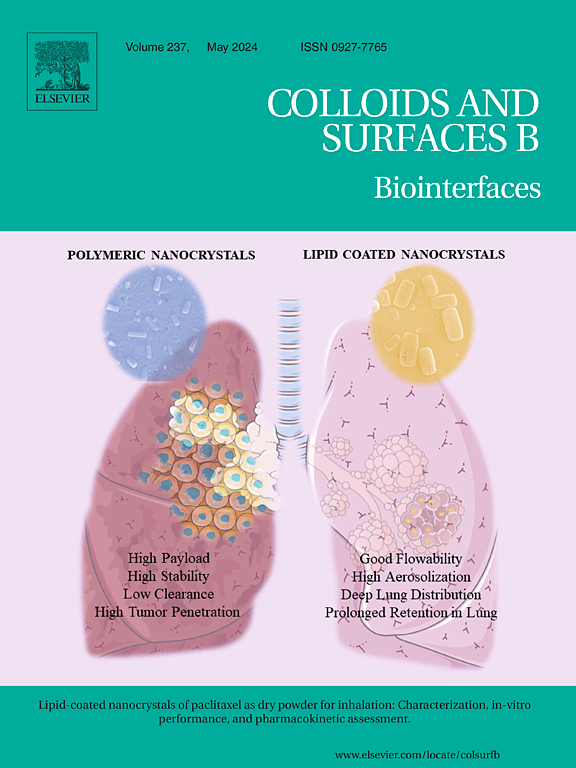Surface-enhanced infrared spectroscopic study of extracellular vesicles using plasmonic gold nanoparticles
IF 5.4
2区 医学
Q1 BIOPHYSICS
引用次数: 0
Abstract
Extracellular vesicles (EVs), sub-micrometer lipid-bound particles released by most cells, are considered a novel area in both biology and medicine. Among characterization methods, infrared (IR) spectroscopy, especially attenuated total reflection (ATR), is a rapidly emerging label-free tool for molecular characterization of EVs. The relatively low number of vesicles in biological fluids (∼1010 particle/mL), however, and the complex content of the EVs’ milieu (protein aggregates, lipoproteins, buffer molecules) might result in poor signal-to-noise ratio in the IR analysis of EVs. Exploiting the increment of the electromagnetic field at the surface of plasmonic nanomaterials, surface-enhanced infrared spectroscopy (SEIRS) provides an amplification of characteristic IR signals of EV samples. Negatively charged citrate-capped and positively charged cysteamine-capped gold nanoparticles with around 10 nm diameter were synthesized and tested with blood-derived EVs. Both types of gold nanoparticles contributed to an enhancement of the EVs’ IR spectroscopic signature. Joint evaluation of UV-Vis and IR spectroscopic results, supported by FF-TEM images, revealed that proper interaction of gold nanoparticles with EVs is crucial, and an aggregation or clustering of gold nanoparticles is necessary to obtain the SEIRS effect. Positively charged gold nanoparticles resulted in higher enhancement, probably due to electrostatic interaction with EVs, commonly negatively charged.
利用等离子金纳米粒子对细胞外囊泡进行表面增强红外光谱研究。
细胞外囊泡(EVs)是大多数细胞释放的亚微米级脂质结合颗粒,被认为是生物学和医学的一个新领域。在各种表征方法中,红外(IR)光谱,尤其是衰减全反射(ATR)光谱,是一种迅速崛起的用于表征细胞外囊泡分子特征的无标记工具。然而,由于生物液体中的囊泡数量相对较少(每毫升中只有 1010 个),而且 EVs 的环境(蛋白质聚集体、脂蛋白、缓冲分子)成分复杂,可能导致 EVs 的红外分析信噪比较低。利用等离子纳米材料表面的电磁场增量,表面增强红外光谱(SEIRS)可以放大 EV 样品的特征红外信号。我们合成了直径约为 10 纳米的带负电荷的柠檬酸盐帽金纳米粒子和带正电荷的半胱胺帽金纳米粒子,并用血源性 EV 进行了测试。两种类型的金纳米粒子都有助于增强 EVs 的红外光谱特征。在 FF-TEM 图像的支持下,对紫外可见光谱和红外光谱结果进行的联合评估显示,金纳米粒子与 EVs 的适当相互作用至关重要,金纳米粒子的聚集或团聚是获得 SEIRS 效果的必要条件。带正电荷的金纳米粒子能产生更高的增强效果,这可能是由于它们与通常带负电荷的 EV 发生了静电作用。
本文章由计算机程序翻译,如有差异,请以英文原文为准。
求助全文
约1分钟内获得全文
求助全文
来源期刊

Colloids and Surfaces B: Biointerfaces
生物-材料科学:生物材料
CiteScore
11.10
自引率
3.40%
发文量
730
审稿时长
42 days
期刊介绍:
Colloids and Surfaces B: Biointerfaces is an international journal devoted to fundamental and applied research on colloid and interfacial phenomena in relation to systems of biological origin, having particular relevance to the medical, pharmaceutical, biotechnological, food and cosmetic fields.
Submissions that: (1) deal solely with biological phenomena and do not describe the physico-chemical or colloid-chemical background and/or mechanism of the phenomena, and (2) deal solely with colloid/interfacial phenomena and do not have appropriate biological content or relevance, are outside the scope of the journal and will not be considered for publication.
The journal publishes regular research papers, reviews, short communications and invited perspective articles, called BioInterface Perspectives. The BioInterface Perspective provide researchers the opportunity to review their own work, as well as provide insight into the work of others that inspired and influenced the author. Regular articles should have a maximum total length of 6,000 words. In addition, a (combined) maximum of 8 normal-sized figures and/or tables is allowed (so for instance 3 tables and 5 figures). For multiple-panel figures each set of two panels equates to one figure. Short communications should not exceed half of the above. It is required to give on the article cover page a short statistical summary of the article listing the total number of words and tables/figures.
 求助内容:
求助内容: 应助结果提醒方式:
应助结果提醒方式:


